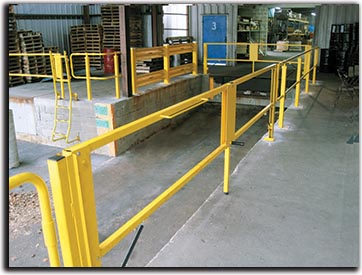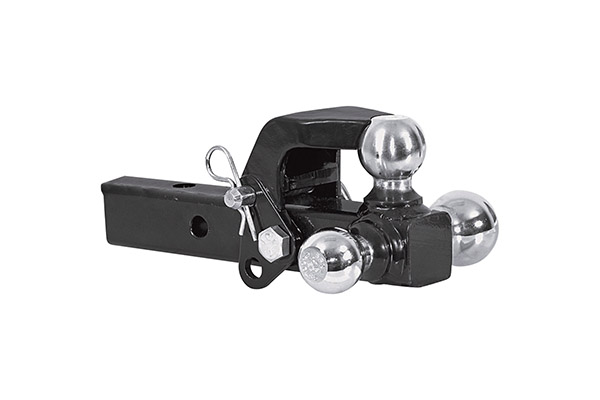Equipment Report: Dock equipment’s moment in the sun
New tools and concepts are transforming the once-neglected dock into a data-driven, process-oriented, much safer place.
Business disruption, labor challenges and technological innovation have made an impact on everything inside the four walls in recent years. Organizations have adapted, invested and scraped for every operational efficiency, but one area has largely escaped this modernization.
“We’re historically some of the most neglected folks in the industry,” says Tim Blohm, vice president of sales for dock equipment manufacturer Poweramp. “Any time a project is over budget, they look at the loading dock.”
Blohm says cutbacks might include selecting mechanical instead of hydraulic levelers, foregoing safety restraints, and skipping or skimping on maintenance of dock equipment until it’s broken.
Jim Galante, director of business development for Southworth Products Corp., agrees this dynamic is fairly common.
“I see companies spend $3 million on a CNC machine that will spit parts into a bucket faster than you can empty it,” Galante says, “but they don’t consider the materials handling impacts.”
Rich Schlesinger, manager of U.S. distribution sales for loading dock products at Entrematic, says dock improvements should not be an afterthought.
“The dock is an area that’s often overlooked, and it’s an area where there is always room for improvement,” Schlesinger says. “You can be as efficient as possible inside the facility, but if you can’t move product out the door or bring raw materials in, all other investments become less impactful.”
Lately, however, signs suggest that dock equipment is finally getting its moment in the sun. The desire to enhance safety and compliance before an incident is driving this change. But, recognition of the dock’s impact on material flow, productivity and efficiency is also playing a role.
Threading the needle
Small and medium-sized businesses are likely to be hit especially hard by mismatches in operations and dock equipment. Galante says the blessing of a thriving economy came with some hidden curses for these companies.
It turns out dock processes are quite sensitive to fluctuations in the broader business. Whether gradual or sudden, changes to the nature of orders can wreak havoc on shipping costs and dock operations. Those accustomed to handling cartons in and cartons out soon find it’s impractical and expensive, Galante says. At some point they might realize they can put six cartons on a pallet for one amount, or send six cartons by UPS for 10 times that amount.

For the many facilities at ground level with no dock, the process of adding unit handling capabilities can be fraught with risk, Galante adds. Is a $25,000 forklift a wise investment? Perhaps a manual or powered stacker could work, assuming the asphalt is as smooth as an ice rink and you only need to place one pallet onto the back of a given truck. A yard ramp is another option, although not all yards can fit an 80-foot semi in addition to a 30-foot ramp. For many, a recessed dock or a surface/pit-mounted dock lift is an economical alternative. In a small industrial strip, a group of manufacturers might even share a portable dock lift.
“Customers want a one-year ROI,” Galante says. “At 1.5 years maybe they’ll think on it, and at two years they wince. But it’s important that relatively small businesses dealing with unit loads know they have choices.”
Immediate needs are one thing, but Schlesinger says it’s essential to consider the ongoing maintenance needs of dock equipment. Mechanical levelers, air-powered levelers and hydraulic levelers have different basic needs and probabilities of downtime, and each is therefore suited to certain applications, not certain budgets.
“Something less expensive on the front end could cost more in maintenance on the back end,” Schlesinger says. “That initial choice is important.”
The rise of dock data
Although disruptive, changes in the format of materials handled at the dock pale in comparison to the changes in activity. With pedestrians, forklifts, trucks, drivers, materials and staging areas all jockeying for space and speed, a potentially hazardous environment could get worse. By the same token, any incident will more severely impact productivity.
Even though too many companies are prompted to change by an incident, some companies are taking proactive steps. Walt Swietlik, director of customer relations and sales support for Rite-Hite, says more and more companies are installing vehicle restraints, levelers and other dock equipment as a package or system. Interlocks are a key feature of the system approach, and consist of mechanical and electronic safety measures that prevent anything but the optimal sequence of events. Vehicle restraints must be positively engaged to open the door, the door must be open to operate the leveler, and so on.
“There’s no doubt the safety message is coming through loud and clear,” Swietlik says. “I’ve been doing this my entire life, and nowadays when a new client comes in it’s not ‘are we or aren’t we going to have a dock lock,’ it’s which kind. It’s an interesting change in the last few years.”

Dock controls are another area that has seen significant modernization. The human-machine interface (HMI) has seen substantial upgrades from the days of pull chains, faded buttons and flashing lights. Schlesinger describes an HMI that consists of a single touchscreen. The only thing the screen displays is the next action a user needs to take. Graphic illustrations communicate clearly what’s happening, and using icons eliminates the need for multiple languages. While analog control panels require a lot of room, Schlesinger says HMI screen control panels can greatly reduce the footprint required on the building wall.
Integrated dock controls also collect valuable data, Schlesinger says, like the fact that docks 1 through 3 are used more often and their planned maintenance schedules should be adjusted accordingly.
Poweramp’s Blohm says data in the future may unlock even more powerful insights. An integrated system could detect truck presence, track leveler cycles, record the duration of each door opening, and quantify utilization by watching how long a door stays open without forklift traffic. This information can help schedule deliveries to avoid backcharges for slow unloading, or to schedule maintenance events during the least disruptive time. Blohm says this allows for much more efficiency at the dock by better distributing equipment usage.
“You will be able to see the busiest docks, the busiest time of day, and safety, operations and maintenance personnel will be automatically alerted to any issues,” Blohm says. “Currently, someone might go around with a clipboard and watch mechanical counters on a leveler, but it’s rare. We’re moving toward the Cloud.”
Manufacturer exceeds OSHA standards with dock safety products
 Precision Gears is a family-run business that operates a state-of-the-art gear manufacturing facility in Pewaukee, Wisc. The company recently evaluated the facility with a critical eye on safety and identified unprotected ledges on the loading dock in the shipping and receiving area. After installing a series of guarding products, the company exceeded OSHA standards while preserving access and efficiency at the dock.
Precision Gears is a family-run business that operates a state-of-the-art gear manufacturing facility in Pewaukee, Wisc. The company recently evaluated the facility with a critical eye on safety and identified unprotected ledges on the loading dock in the shipping and receiving area. After installing a series of guarding products, the company exceeded OSHA standards while preserving access and efficiency at the dock.
OSHA requires guarding for heights above 48 inches, and after measuring the heights around his loading dock, Ronald Vincze, quality manager, believed it was time to look into outfitting the area with better guarding protection. He began researching products that would protect employees, visitors and truck drivers. Coincidentally, Vincze was actively working on getting protection installed in the loading dock area when OSHA paid a surprise visit.
The loading dock is primarily used for shipping and receiving, including all raw goods for manufacturing. The dock is fairly typical, but it’s equipped with overhead crane access for flatbed trucks and has a horseshoe configuration with various access points and multiple doors.
“The goal was to fully protect the area and do it right the first time,” Vincze said. “I wanted to make sure we had complete protection for our exposed edges for all of our employees. We went beyond the OSHA requirements and installed products that protect the exposed edges, protect our employees and provide the access we need to get materials into our bay.”
Manufactured from steel and tested for impact resistance, the guarding products (Wildeck) provide complete safety coverage to all of the dock’s access points while meeting clearance requirements of the dock overhang and the overhead crane.
“All of the products are working great,” Vincze said. “We’ve had zero complaints from truck drivers or employees.”
Safe harbor
Technology is revolutionizing dock safety, but low-tech solutions like barriers will always be needed. Forklifts will always rush around, and the pressure to move faster will always be there, according to Cory Thomas, product manager of guarding products at Wildeck. A guard or gate can help forklift drivers realize where they are and what’s around them.
“Companies still use tape on the floor, but more are spending money on the docks, at least to get some guards up,” Thomas says. “They’re realizing a forklift or person can easily step over tape, so customers are starting to think of the dock more in terms of process and a flow of goods.”
Aisles dedicated for pedestrians or forklifts help ensure traffic behaves in a certain way, Thomas says, and when you clear a way for forklifts, they can drive faster. He recommends examining the facility flow, identifying areas where issues could arise and correcting them first. Dock pit ladders, for example, allow drivers to enter the building without going in front of or between other trucks. One of the most frequent calls Thomas gets is from companies with elevated docks with no gates. Protecting all edges for loading and unloading is low-hanging fruit for many operations.
“It’s a lot easier to explain the benefits of creating aisles and protection after an incident, so beforehand it’s a matter of explaining what they can avoid,” Thomas says. “From speaking with people with dock safety products, they get things done faster because they’re more organized. There are productivity benefits along with the safety features.”
Just three or four years ago, few were thinking of these concepts at the dock, Swietlik says. The next objective, he suggests, is using data and equipment to turn trailers quicker. The meaning of “quicker” will be different for each customer.
“The definition of productivity at the loading dock is a moving target in my estimation,” Swietlik says. “One company might think they are fast if they turn a trailer in two hours. For another, if they can’t do it in an hour it’s a catastrophe. Another might aim for 15 minutes.”
The folks around the two-hour threshold are concerned with scheduling the truck, Swietlik says, and making sure they know when it arrives and if a dock is available. “He’s probably getting banged up on demurrage charges,” Swietlik says.
The biggest challenge, he adds, is getting organized with the right people in the right place to keep track of all the moving pieces. There’s an opportunity to monitor traffic flow, manage company assets like lift trucks and drivers, have discipline in the staging area, get a better handle on when trucks will arrive, and ensure everything is ready when they do.
On the inbound side, reliability has become critical, according to Swietlik. This is especially true for production because fewer companies are keeping pre-production inventory around. A just-in-time approach with a limited number of docks, however, can cause headaches. If one of five docks is down, you’ve lost 20% of your capability.
“Everyone is strained to get material in and product out, and they’re further strained by the absence of people in the lobby applying for work,” Galante says. “I don’t know of a business that has enough people. So, you have to take care of the people you have and make them more efficient.”
Companies mentioned in this article:
View Dock Equipment Products and Accessories
 G1 bug screen door
G1 bug screen door
Bug screen dock door keeps insects, birds out..
 Smart-Hook vehicle restraint
Smart-Hook vehicle restraint
Prevent unscheduled trailer departure.
 Pivot 2.0 fan
Pivot 2.0 fan
Mount fan in variety of tight spaces.
 Mobile Speed-Lift
Mobile Speed-Lift
The world’s first self-powered mobile dock lift.
 Uni-Dox inflatable shelter
Uni-Dox inflatable shelter
Accommodate multiple trailers with shelter.
 Ultra-Tow line of parts and accessories
Ultra-Tow line of parts and accessories
Cargo carriers, ramps for safe and secure transportation.

Article Topics
Loading Dock Equipment News & Resources
Rite-Hite ONE digital platform debuts ASSA ABLOY acquires Integrated Warehouse Solutions in the U.S. Destination: Loading dock safety Yusen Logistics partners with Pickle Robot to streamline container unloading Miner Limited, an OnPoint Group company, acquires Bob’s Overhead Door Miner Limited acquires Central State Door Service Loading Dock Safety with New Trailer Designs More Loading Dock EquipmentLatest in Materials Handling
ASME Foundation wins grant for technical workforce development The (Not So) Secret Weapons: How Key Cabinets and Asset Management Lockers Are Changing Supply Chain Operations MODEX C-Suite Interview with Harold Vanasse: The perfect blend of automation and sustainability Consultant and industry leader John M. Hill passes on at age 86 Registration open for Pack Expo International 2024 Walmart chooses Swisslog AS/RS and software for third milk processing facility NetLogistik partners with Vuzix subsidiary Moviynt to offer mobility solutions for warehouses More Materials HandlingAbout the Author
Subscribe to Materials Handling Magazine

Find out what the world's most innovative companies are doing to improve productivity in their plants and distribution centers.
Start your FREE subscription today.
April 2024 Modern Materials Handling

Latest Resources












